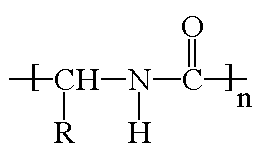Polymers from Sharks

There are many natural polymers from sharks and many uses for those shark parts. A popular one is their cartilage.
Cartilage is used for severe burns and even sold as a curative powder.
Octopi, squid, and
stingrays are other sea creatures who also contain cartilage.
Cartilage is a type of protein made up of a mixture of amino acids. Proteins do many things in living creatures, from building up tough structures like cartilage and tendons to catalyzing chemical reactions.
The general repeat unit of a protein polymer looks like this:

 The
skins of sharks were rough enough to be used as a sandpaper long
before trees were used to make paper. The skin is made up of tiny
projections called dermal denticles, which when added to the
aerodynamic shape of sharks, makes it easy to believe that they can
travel at very fast and efficient speeds. Take a look below at some of the sharks
found in our oceans; they even LOOK fast and deadly! (Image kindly provided by
Frankomaps.com- thanks!)
The
skins of sharks were rough enough to be used as a sandpaper long
before trees were used to make paper. The skin is made up of tiny
projections called dermal denticles, which when added to the
aerodynamic shape of sharks, makes it easy to believe that they can
travel at very fast and efficient speeds. Take a look below at some of the sharks
found in our oceans; they even LOOK fast and deadly! (Image kindly provided by
Frankomaps.com- thanks!)

Shark skin was tanned into a leather by a
process called crosslinking, and
has been used to make wallets, belts, and the handle grips of swords.
A product, but not necessarily a polymer from sharks, is oil
The oils from shark liver were used a long time ago much like the oils
of whales and turtles.
Humans collected these oils and used them as fuels for lamps and later
as ingredients for cosmetics, such as hand creams and lipstick.
And you were wondering what the 'secret ingredient' was.
Some sharks are scavengers. The tiger shark, for example, feeds on anything it can find, which is sometimes not even living creatures. Some sharks are predators which hunt down other creatures in the sea such as seals, squids, and even other sharks. Some sharks and their relatives, such as stingrays (image below), feed on creatures found on coral reefs such as fish and crabs. Others, like the whale shark (seen in the image above), feed on plankton which is abundant in the ocean. Thanks again to Frankomaps.com for the image!

Some of the non-polymer materials includes the meat of sharks which was and is still a main food source in some places in the world, and the fins of sharks which are used to make soup. Harvesting shark fins, though, is actually an ecological disaster. Here's why: they catch and kill the sharks, cut off the fins, and then just throw the rest of the sharks back into the ocean. What a waste!